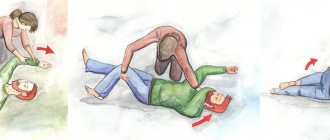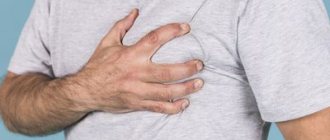These figures could be less frightening if the victims had time to receive professional, timely assistance.
To attract public attention to the problem, Red Cross and Red Crescent activists initiated the celebration of World First Aid Day. Traditionally, this holiday is celebrated on the second Saturday of September; this year it falls on the 12th. To support this event, we will talk about how to help someone who is fainting.
First aid for fainting
It is necessary to make sure that the person is breathing. You need to tilt the person’s head back and pay attention to whether the chest is moving, feel the pulse on the carotid artery, and place your palms on your mouth. In order to improve blood circulation, you need to elevate the patient's legs. It is advisable to turn your head to the side so that in case of vomiting, aspiration does not occur. If a person is unconscious, bring ammonia under his nose.
Important: do not use the entire bottle, it is better to apply a few drops on a cotton swab. Otherwise, you can get burned, and in children you can even stop breathing. If ammonia is not available, you need to press on the painful point between the nose and upper lip.
There is no need to panic and do not overdo it in providing assistance.
Signs and symptoms of fainting
Syncope is a condition that indicates a lack of oxygen and the possible presence of a disease in the human body. Fainting becomes a wake-up call to visit specialists with medical education, undergo a full diagnosis and take the necessary tests.
The main signs and symptoms of syncope are:
- shallow, barely audible breathing;
- rare and weak pulse;
- brief absence of consciousness.
If a person has lost consciousness for a short time, he should be placed on a couch or bed in a horizontal position and the lower limbs should be slightly elevated. If the victim feels significantly better after 15-30 minutes, then it was fainting.
Fainting is also characterized by: noise in the organ of hearing; severe weakness; dizziness; nausea; the appearance of cold sweat; numbness of the legs; the appearance of a veil in front of the organ of vision.
What should you do after fainting?
If fainting lasts less than 5 minutes and does not have additional symptoms, then there is no need to worry. You just need to rest for your body to recover.
what to do after fainting
But there are indications that require immediate consultation with a doctor:
- If you hit your head when you fall.
- 2 or more fainting episodes per month.
- A pregnant woman or a person with any cardiovascular diagnosis lost consciousness.
Only a doctor will be able to determine whether there is cause for concern and, if necessary, prescribe additional examination.
Treatment
First aid for fainting consists of clearing the airways and placing the patient on a flat surface with the legs raised and the head turned to the side to prevent the tongue from retracting. The elevated position of the lower extremities will help increase blood flow to the brain. Irritating substances are also used, for example, ammonia or cold water on the face.
Drug therapy is based on the use of drugs that increase blood pressure and vascular tone, such as cordiamine and ephedrine.
Why might fainting happen?
The cause of fainting is a lack of oxygen for optimal functioning of the brain. Reasons for this condition:
- Sudden change in body position. If you sit or lie down for a long time and then quickly get up, your heart may simply not have time to pump blood to your head.
- Blood loss. Due to injury, hemorrhage, internal bleeding.
- Dehydration.
- Intoxication. Moreover, they have completely different etiologies: alcoholic, infectious, food.
- Endocrine dysfunction: thyroid pathology, diabetes mellitus.
- Starvation. Due to lack of nutrients, the production of red blood cells and hemoglobin in it is reduced. As a result, a drop in blood pressure.
- Decreased oxygen supply to the brain.
- Diseases of the cardiovascular system.
Often completely harmless situations lead to fainting, but sometimes there are serious health problems.
Distinguishing features of syncope from coma
Syncope is a short-term state and is accompanied by short-term memory loss and decreased muscle tone. When you faint, breathing, swallowing and other protective reflexes do not disappear, so there is no danger of suffocation (asphyxia).
Best materials of the month
- Coronaviruses: SARS-CoV-2 (COVID-19)
- Antibiotics for the prevention and treatment of COVID-19: how effective are they?
- The most common "office" diseases
- Does vodka kill coronavirus?
- How to stay alive on our roads?
During a coma, the muscles relax and the tongue sinks, as a result of which the airways are clogged, therefore, there is a possibility of suffocation. Fainting quite often develops into a coma, which is a serious danger to human life. This transition is possible due to a sharp fall and a blow to the back of the head. Due to severe bruising, there is a risk of seizures, which are a symptom of normalization of blood circulation in the brain. The most important thing is not to confuse seizures with an epileptic attack.
Accompanying symptoms
There comes a moment of loss of consciousness - blood pressure drops sharply, it is very difficult to listen to heart sounds, the pulse is thread-like, practically not palpable during palpation (it can be extremely frequent or rare). The muscles are in a state of sharp relaxation, neurological signs are absent or maximally reduced, which is typical for this condition. The pupils are dilated and react poorly to light reactions. The duration of fainting ranges from a few seconds to five minutes. In the case of a longer period of attack, a protracted (deep fainting) occurs, accompanied by convulsions and involuntary urination. Some fall with their eyes open, which later causes dryness. To prevent the mucous membranes from drying out, a sterile napkin is placed on top. It is possible to distinguish true fainting from epileptic fainting by comparing the symptoms: in the first case, the patient does not bite his tongue, there are no clonic convulsions with adversive spasm.
Diet
Diet for the nervous system
- Efficacy: therapeutic effect after 2 months
- Timing: constantly
- Cost of food: 1700-1800 rubles per week
Nutrition for people prone to fainting should be complete and varied. To choose the right diet, first of all, you need to find out the cause of such manifestations. The diet is formed depending on the presence or absence of heart disease, vascular disease, diabetes mellitus , etc. The basic nutritional rules should be as follows:
- The menu should be dominated by fresh and properly processed products.
- The diet should be varied to provide the body with essential microelements and vitamins .
- It is better to eat food 5-6 times a day in small portions to prevent the feeling of extreme hunger.
- If the state of the body allows, you need to introduce as many vegetables and fruits into your diet as possible.
- Proper drinking regime is necessary, because dehydration can also cause fainting.
If a person experiences reflex fainting, he should adhere to the principles of a diet for the nervous system .
How does loss of consciousness manifest?
Fainting rarely happens suddenly. As a rule, the body tries to signal about this.
The signals given by the body can manifest themselves in the form of ringing in the ears, severe nausea, and dizziness. A person may experience severe weakness, and in some cases, blurred vision.
Some people note that before fainting their arms and legs may go numb. Cold sweat appears, sometimes there is a feeling that there is an area of emptiness directly in the head.
You can also recognize impending fainting from the outside. Before losing consciousness, a person becomes pale, his pulse noticeably weakens. This is accompanied by a rapid decrease in blood pressure. Immediately after this, muscle tone disappears, and the person’s eyes simply close and he falls unconscious.
List of sources
- Bova A.A. Syncope in clinical practice: educational method. allowance. – Mn.: Asobny, 2009. – 45 p.
- Autonomic disorders: Clinic, treatment, diagnosis / ed. AM Wayne. – M., 1998. – 752 p.
- Guseva I.A., Bondareva Z.G., Miller O.N. Causes of syncope in young people // Ros. cardiology journal. - 2003. - No. 3. — P. 25-28.
- Stykan O.A. Akimova G.A. Differential diagnosis of nervous diseases: a guide for doctors. - St. Petersburg: Hippocrates, 2000. - P. 132-177.
Procedures and operations
If vasovagal syncope recurs frequently, it is recommended to increase your fluid and salt intake.
People who are prone to reflex fainting are taught to recognize the signs of presyncope and take steps to prevent loss of consciousness. They are also advised to change their lifestyle and avoid the influence of provoking factors.
In some cases, no special treatment is required.
In general, the choice of treatment tactics depends on what specific problem caused the disturbance of consciousness.
Tests and diagnostics
To determine why a person is losing consciousness, the doctor takes the following steps:
- Performs initial condition assessment. To do this, anamnesis is collected or, if necessary, an interview with eyewitnesses is carried out. It is important to find out whether an episode of loss of consciousness or multiple fainting episodes actually occurred.
- Takes into account the likelihood of psychogenic attacks or epileptic seizures and carries out differential diagnosis.
- Orders the necessary studies.
In the diagnostic process, if necessary, the following methods are practiced:
- Physical examination.
- Electrocardiogram.
- Daily ECG monitoring.
- Ultrasound to determine structural changes in the heart.
- Orthostatic test.
- Clinical stress test to determine myocardial hypoxia
- Coronary angiography.
- Blood test with determination of hematocrit, hemoglobin , oxygen saturation, troponin level, etc.
If necessary, other studies and laboratory tests are prescribed.
Forecast
According to medical statistics, in approximately 93% of cases, benign fainting occurs with a favorable prognosis, which does not require drug treatment.
An unfavorable prognosis is observed in those patients in whom fainting is provoked by cardiovascular disease . These people are at risk of death due to heart problems. Risk factors for sudden death in patients with syncope are as follows:
- Age over 45 years.
- Ventricular arrhythmias.
- Heart failure.
- The presence of pathological changes on the ECG, which indicate arrhythmogenic disorders.
- Myocardial infarction.
- Hypertrophic cardiomyopathy.
- Arrhythmogenic right ventricular cardiomyopathy.
Consequences and complications
The consequences of such a condition depend on the causes of its occurrence. The most serious consequences may be:
- Development of coma and cerebral edema , which leads to disorders of important life functions.
- Suffocation due to retraction of the tongue in an unconscious state.
- Various injuries received during a fall.
With frequent manifestations of this condition, a person sometimes has to change his occupation.
What happens when you lose consciousness
Experts believe that during loss of consciousness, the part of the brain that is responsible for thinking stops working.
This is why conscious awareness of what is happening around is also switched off. At the same time, when you lose consciousness, the brain does not turn off completely. At the same time, those parts of the brain that are responsible for regulating blood circulation and the breathing process continue to work without interruption (for example, the medulla oblongata of the brain continues to work in exactly the same mode as when a person is conscious).
In what cases does loss of consciousness develop?
At risk (that is, a group of people especially susceptible to fainting) are those who have suffered various nervous disorders or suffer from some kind of phobia. In this case, even a strong emotional shock will not be needed to lose consciousness; fainting can be the result of any factor that provokes the phobia. Such a factor could be, for example, a simple medical needle, but fainting should be considered more of a reflex reaction of the body.
Fainting may occur in cigarette lovers. Heavy smokers are especially at risk of losing consciousness; fainting can occur after a long bout of coughing.
In the case of smokers, the main cause of fainting is lack of oxygen. The fact is that most of them suffer from chronic diseases that negatively affect the bronchopulmonary system. As a result, venous congestion develops and during coughing it provokes the development of severe oxygen deficiency.
However, a healthy person can lose consciousness, for example, as a result of physical exertion that is unusual for the body. For example, running too fast or lifting excessive weights can cause fainting.
People with unstable blood pressure should perform any activity smoothly. For example, moving too quickly from a horizontal to a vertical position can cause fainting. This is why doctors recommend that such people get out of bed slowly and smoothly. This recommendation is especially important in the morning, when a person is not yet fully awake. At this time, the body is not yet 100% ready for normal stress.
Even the usual sudden throwing of the head back can provoke fainting. So an ordinary visit to the hairdresser or dentist can end in loss of consciousness.
Another factor that quite often provokes fainting is hunger. Many girls are keen on diets, but not all of them consult specialists about this. As a result, uncontrolled strict diets cause exhaustion of the body, and the girls themselves can become victims of hungry fainting at any moment. The same reason is true for all people who are malnourished.
This is not a list of all the reasons that can cause loss of consciousness. In addition to overwork, overheating, excessive vomiting or nosebleeds, the cause of fainting can be alcoholic beverages (more precisely, their abuse). Even energy drinks or drinks containing caffeine can have a similar effect.
Sometimes fainting is a manifestation of a fairly serious illness. For example, anemia, a number of diseases of the vascular system, and heart disease can also cause loss of consciousness.
Respiratory failure, damage to the body by powerful infections can also cause fainting. Severe intoxication (vapors and gases) can have a similar effect. Head injuries and past pathological conditions can also be attributed to the causes of loss of consciousness. Fainting can even be caused by diseases of the cervical spine (for example, common osteochondrosis).
Regular fainting may be a cause for serious concern. It doesn’t really matter how long after the primary fainting the secondary loss of consciousness occurred (a day, a week or two). In any case, if the loss of consciousness is systemic, you need to consult a doctor.
Causes
The causes of hungry fainting may be limited not only to an empty stomach, but also indicate various nutritional disorders. These include an unbalanced diet, mono-diets (preference for one type of food), as well as insufficient consumption of proteins, fats and carbohydrates (BZHU). At the same time, hungry fainting can be caused by a lack of calories.
In a balanced diet, the BJU ratio should be 1:1:5 for children, and 1:1:4 for adults.
BJU and caloric intake norms per day:
| Age | Proteins (g) | Fat (g) | Carbohydrates (g) | Calorie content (kcal) |
| Children: | ||||
| up to 7 years | 65 | 60 | 260 | 1800 |
| after 7 years | 80-110 | 80-110 | 300-450 | 2300-2700 |
| Adults: | ||||
| men | 80-90 | 50-60 | 300-400 | 2200-2600 |
| women | 70-80 | 50-55 | 300-370 | 1800-2200 |
| Pregnant | 100 | 70 | 240 | 2000-2500 |
| Nursing | 110 | 80 | 260 | +500 kcal |
Of course, everything is not so simple. It is better to make the calculation individually, taking into account the general condition of the body, level of load, height and weight. There are special calculators for this.
In addition to poor nutrition, stressful situations and physical exhaustion can aggravate the situation, since they require increased consumption of nutrients and energy due to changing metabolism. And if the body already receives less than is necessary to maintain normal life, then loss of consciousness is possible.
So, if you adhere to a balanced diet, observe a work and rest schedule, and take meals on time, then you don’t have to be afraid of fainting from hunger.









